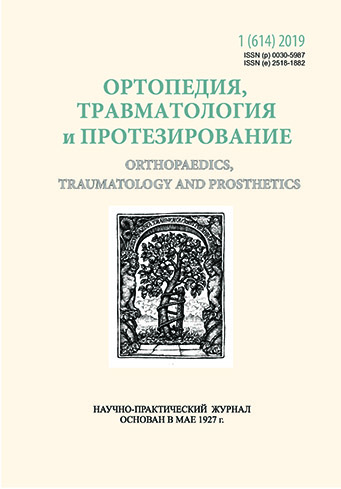Dynamic of functional parameters of cardio-vascular system in patients with vertebrogenic pathology after body position changes
DOI:
https://doi.org/10.15674/0030-59872019125-30Keywords:
body mass index, hemodynamics, prone positionAbstract
Postural hemodynamic reactions are well-known but their dependency on anthropometrics is still not fully studied. A significant amount of surgeries are provided in prone position, so it is important for anesthesiologist to predict specific physiologic changes.
Objectives: to study patterns of functional changes in cardiovascular system in patients with vertebrogenic pathology after turning from supine to prone position and the influence of age and body mass index on them.
Material and methods: we examined 200 patients of 18–75 y. o.; 118 male and 82 female. In group І there were patients with body mass index ≤ 25 kg/m2 and in group ІІ – patients with body mass index > 25 kg/m2 . Hemodynamics were examined by thoracic rheography in supine position, in prone position 5 min after turning and in prone position 20 min after turning.
Results: in patients of group ІІ vs patients of group A we foundnd significantly higher level of systolic BP in 5 min and 20 min after turning to prone position, and diastolic BP, mean BP and peripheral vascular resistance at all stages of study. Stroke volume index and cardiac index were significantly lower at all stages of studied patients of group ІІ. After turning into prone position diastolic BP and peripheral vascular resistance increased by 15,2 % in all patients, but in patients with body mass index > 25 kg/m2 it did not reverse to basal level. Cardiac index changed only in patients of group ІІ. Stroke volume index decreased by 13,6 % in all patients, but in 20 min it became normal only in patients of group І and was low in patients of group ІІ.
Conclusions: compensatory reaction of cardiovascular system after turning to prone position depended on age and body mass index. Dependence on body mass index is more significant and anesthesiologist should be aware of these changes when planning anesthesia in prone position.
References
- Wu, C., Lee, T., Chan, K., Jeng, C., & Cheng, Y. (2012). Does targeted pre-load optimisation by stroke volume variation attenuate a reduction in cardiac output in the prone position. Anaesthesia, 67 (7), 760–764. doi:10.1111/j.1365-2044.2012.07116.x
- Kim, D., Shin, S., Kim, J. Y., Kim, S. H., Jo, M., & Choi, Y. S. (2018). Pulse pressure variation and pleth variability index as predictors of fluid responsiveness in patients undergoing spinal surgery in the prone position. Therapeutics and Clinical Risk Management, 14, 1175–1183. doi:10.2147/tcrm.s170395
- Leslie, K., Wu, C. Y., Bjorksten, A. R., Williams, D. L., Ludbrook, G., & Williamson, E. (2011). Cardiac output and propofol concentrations in prone surgical patients. Anaesthesia and Intensive Care, 39 (5), 868–874. doi:10.1177/0310057x1103900511
- Lyzohub, M. V., Kostrikova, E. V., & Khmyzov, A. O. (2013). Surgical anesthesia in patients in prone position. Orthopaedics, Traumatology and Prosthetics, 3, 99–106. doi: 10.15674/0030-59872013399-106 (in Ukrainian)
- Logacheva, I. V., Rjazanova, T. A., Makarova V. R., Avzalova, F. R. & Maksimov, N. I. (2017). Remodeling of the heart in patients with increased body weight and obesity and comorbid pathology. Russian Journal of Cardiology, 4 (144), 40–46. doi: 10.15829/1560-4071-2017-4-40-46 (In Russian)
- Shimizu, M., Fujii, H., Yamawake, N., & Nishizaki, M. (2015). Cardiac function changes with switching from the supine to prone position: Analysis by quantitative semiconductor gated single-photon emission computed tomography. Journal of Nuclear Cardiology, 22 (2), 301–307. doi:10.1007/s12350-014-0058-3
Downloads
How to Cite
Issue
Section
License
Copyright (c) 2019 Mykola Lyzohub, Igor Kotulskiy, Natalya Moskalenko, Victoriia Pishchik

This work is licensed under a Creative Commons Attribution 4.0 International License.
The authors retain the right of authorship of their manuscript and pass the journal the right of the first publication of this article, which automatically become available from the date of publication under the terms of Creative Commons Attribution License, which allows others to freely distribute the published manuscript with mandatory linking to authors of the original research and the first publication of this one in this journal.
Authors have the right to enter into a separate supplemental agreement on the additional non-exclusive distribution of manuscript in the form in which it was published by the journal (i.e. to put work in electronic storage of an institution or publish as a part of the book) while maintaining the reference to the first publication of the manuscript in this journal.
The editorial policy of the journal allows authors and encourages manuscript accommodation online (i.e. in storage of an institution or on the personal websites) as before submission of the manuscript to the editorial office, and during its editorial processing because it contributes to productive scientific discussion and positively affects the efficiency and dynamics of the published manuscript citation (see The Effect of Open Access).














